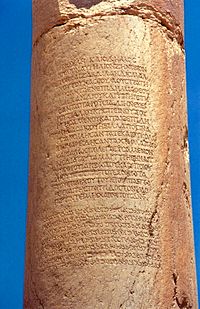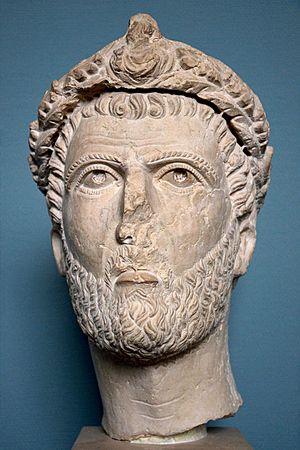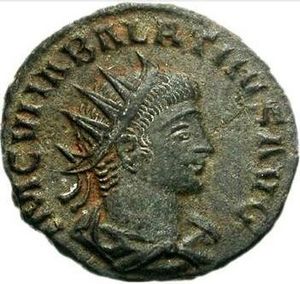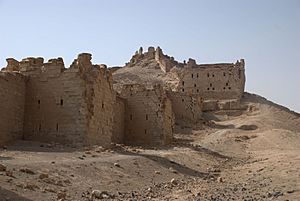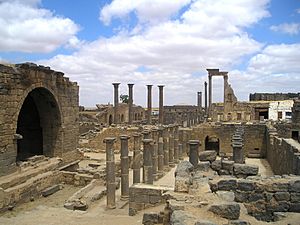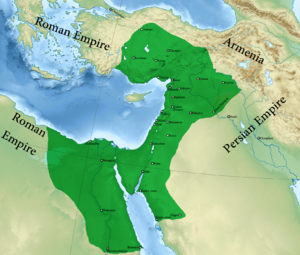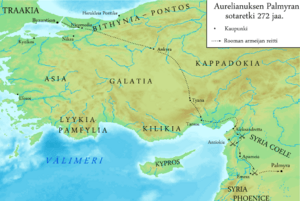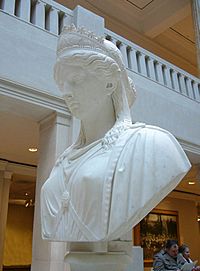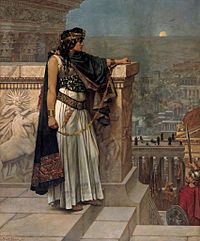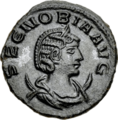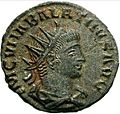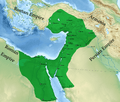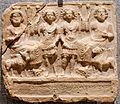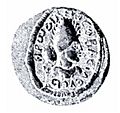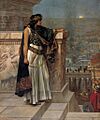Zenobia facts for kids
Quick facts for kids Zenobia𐡡𐡶𐡦𐡡𐡩 |
|||||||||
|---|---|---|---|---|---|---|---|---|---|
| Augusta | |||||||||
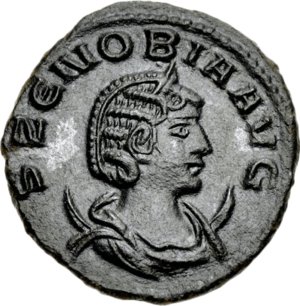
Zenobia as empress on the obverse of an antoninianus (AD 272)
|
|||||||||
| Empress of Palmyra | |||||||||
| Reign | AD 272 | ||||||||
| Co-monarch | Vaballathus | ||||||||
| Queen mother (regent) of Palmyra | |||||||||
| Regency | 267–272 | ||||||||
| Monarch | Vaballathus | ||||||||
| Queen consort of Palmyra | |||||||||
| Tenure | 260–267 | ||||||||
| Born | Septimia Btzby (Bat-Zabbai) c. 240 Palmyra, Syria |
||||||||
| Died | After 274 | ||||||||
| Spouse | Odaenathus | ||||||||
| Issue |
|
||||||||
|
|||||||||
| House | House of Odaenathus | ||||||||
Septimia Zenobia (born around 240 AD – died after 274 AD) was a powerful queen of the Palmyrene Empire in Syria. She was likely from a noble family and married Odaenathus, the ruler of Palmyra.
Her husband became king in 260 AD. He made Palmyra very strong in the Near East by defeating the Sasanian Empire and bringing stability to the Roman East. After Odaenathus was killed, Zenobia became the regent for her young son, Vaballathus. She held the real power during his rule.
In 270 AD, Zenobia launched an invasion that brought much of the Roman East under her control. This included Egypt. By mid-271 AD, her empire stretched from central Anatolia to Upper Egypt. She was still officially under Rome, but in 272 AD, when the Roman emperor Aurelian marched against her, Zenobia declared her son emperor and herself empress. This meant Palmyra was breaking away from Rome.
The Romans won after tough battles. Zenobia was surrounded in her capital city and captured by Aurelian. She was sent to Rome, where she lived the rest of her life.
Zenobia was a queen who loved learning. She welcomed scholars and thinkers to her court. She was also kind to her people and protected different religious groups. Her rule was stable, overseeing an empire with many cultures and peoples. Zenobia's story has inspired many historians, artists, and writers. She is seen as a symbol of patriotism in Syria.
Contents
Who Was Zenobia?
Zenobia was born around 240 or 241 AD. Her Roman family name was Septimia. Her native Palmyrene name was Bat-Zabbai, which means "daughter of Zabbai" in Aramaic. In Greek, which was a common language in Palmyra, she used the name Zenobia. This name means "one whose life comes from Zeus".
No statues of Zenobia from her time have been found. Most pictures of her come from coins. These coins show an idealized image, not her exact look.
Historians learn about Zenobia from old writings, but many of these stories are not fully accurate. The Historia Augusta, a collection of Roman biographies, is a main source, but it often made up events. Other sources, like the Byzantine writer Joannes Zonaras, are considered more reliable.
Zenobia's Family and Early Life
Palmyra was a mix of different peoples, including Arabs and Arameans. Zenobia, as a Palmyrene, likely had ancestors from both groups. Not much is known about her parents.
As a noble girl, Zenobia probably received a good education. Some stories say she enjoyed hunting as a child. She was said to speak Egyptian, Greek, and Latin, in addition to her native Palmyrene Aramaic.
Around 255 AD, when she was about 14, Zenobia became the second wife of Odaenathus. He was the leader of Palmyra. Noble families in Palmyra often married each other, so Zenobia and Odaenathus might have been distant relatives.
Evidence from Ancient Inscriptions
Historians have used old inscriptions to guess who Zenobia's father might have been.
One inscription mentions "Septimia Bat-Zabbai, daughter of Antiochus." This suggests her father might have been named Antiochus. Some scholars think this Antiochus could have been a distant royal ancestor, like a Seleucid king. However, others believe he was a more direct relative, as he is mentioned without a royal title.
Based on her Palmyrene name, Bat Zabbai, her father might have been named Zabbai. Or Zabbai could have been an older ancestor.
Stories from Ancient Sources
The Historia Augusta claims Zenobia was a descendant of Cleopatra, the famous Egyptian queen. This connection might have been made up by Zenobia's enemies to make her look bad, or by Zenobia herself to gain support in Egypt. It's very unlikely she was actually related to Cleopatra.
Medieval Arabic stories also talk about a queen of Palmyra named al-Zabba'. These stories are often mixed with legends. They describe her as a powerful queen who ruled Palmyra and fought against her enemies.
Queen of Palmyra
Zenobia as Queen Consort
Palmyra was a city under the Roman Empire. In 260 AD, the Roman emperor Valerian was captured by the Persians. Odaenathus, who was loyal to Rome, was declared king of Palmyra. He successfully fought against Persia and was named "King of Kings of the East" in 263 AD. He also received many Roman titles, giving him great power in the eastern Roman lands.
In 267 AD, Odaenathus and his eldest son were killed. Zenobia was in her late twenties or early thirties at this time. It's not clear exactly when Zenobia officially became "queen of Palmyra," but she was likely given the title when her husband became king. As queen consort, she was not very active in public life. Some later stories say she joined her husband on his military campaigns. If true, this would have helped her gain influence with the soldiers.
Zenobia as Regent
After Odaenathus's death, power smoothly passed to his and Zenobia's ten-year-old son, Vaballathus. Zenobia became his regent, meaning she ruled in his place because he was too young. Although she never claimed to rule on her own, Zenobia held all the real power. Vaballathus remained in his mother's shadow.
Building Power
The Palmyrene kingdom was new, and loyalty was mainly to Odaenathus. Zenobia needed to make sure her son's rule was accepted. She stressed that her son was continuing his father's legacy. Vaballathus immediately took on his father's royal titles, like "King of Kings."
Odaenathus had controlled a large part of the Roman East. The Roman emperor had accepted his power. However, Odaenathus's Roman titles were not meant to be passed down. Vaballathus had a right to his royal titles, but not to the Roman ones. Zenobia used these Roman titles for her son anyway, which upset the Roman Empire. This disagreement was the first step towards war between Rome and Palmyra.
Early Rule
Historians debate how much land Zenobia controlled at first. Some believe she only ruled Palmyra and Emesa until 270 AD. Others think she ruled all the lands her husband had controlled. Ancient writers support this, saying she inherited her husband's power. Zenobia focused on protecting the borders with Persia and keeping peace with local tribes. She built up forts along the Euphrates river, including Halabiye, which was later renamed "Zenobia" after her.
Expanding the Empire
In 269 AD, while the Roman emperor was busy fighting invaders in Europe, Zenobia strengthened her power. Roman officials in the East were caught between loyalty to the emperor and Zenobia's growing demands. It's unclear why Zenobia decided to use military force. Some suggest Roman officials refused to recognize her authority. Others believe Rome was too weak to protect the provinces, so Zenobia felt she had to take direct control. Some historians also think she wanted to protect Palmyra's trade routes.
Conquering Syria and Arabia
In spring 270 AD, Zenobia sent her general, Septimius Zabdas, to Bostra, the capital of a Roman province. The Roman governor was defeated and killed. Zabdas sacked the city. Palmyra then took control of Arabia and Judea. Syria was easier to conquer because Zenobia had strong support there, especially in Antioch. By November 270 AD, coins were being made in Antioch with Vaballathus's name on them.
The milestones in Arabia called Vaballathus a Roman governor and commander. This was probably to make Zenobia's control seem legitimate, not yet a full takeover of the empire. She could still claim she was helping the Roman emperor by securing the eastern lands.
Taking Over Egypt and Asia Minor
The invasion of Egypt might have been to secure new trade routes or simply because Zenobia was ambitious. The Roman prefect of Egypt was away fighting pirates, making it easier for Palmyra. Zenobia's forces were helped by an Egyptian general named Timagenes. Zabdas entered Egypt with 70,000 soldiers and defeated a Roman army. After some back-and-forth fighting, Egypt became part of Palmyra.
Zenobia's general, Zabdas, also led an invasion into Asia Minor in 271 AD. They took over Galatia and reached Ancyra. However, the western part of Asia Minor remained outside Zenobia's control. By August 271 AD, Zabdas was back in Palmyra, and the Palmyrene Empire was at its largest.
How Zenobia Ruled
Zenobia ruled an empire with many different peoples. She was used to this, as Palmyra itself was a diverse city. Her empire had both Eastern-Semitic and Greek-influenced areas. Zenobia tried to please both groups. She presented herself as a Syrian queen, a Greek queen, and a Roman empress, which helped her gain wide support.
Culture and Learning
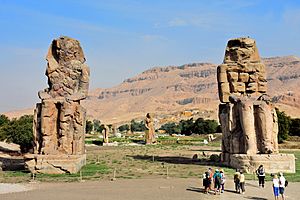
Zenobia made her court a place of learning. Many thinkers and scholars came to Palmyra during her rule. One famous philosopher was Longinus, who taught Zenobia. Some historians blamed Longinus for influencing Zenobia to oppose Rome, but Zenobia was a strong leader who made her own decisions.
Zenobia also started projects to restore ancient sites in Egypt. She may have repaired one of the Colossi of Memnon, which was famous for making a singing sound.
Religion and Tolerance
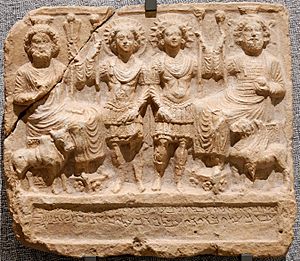
Zenobia followed the traditional Palmyrene religion, which worshipped many Semitic gods. However, she was tolerant of Christians and Jews. Some sources even claimed she was a Manichaean or a Jew, but it's more likely she simply allowed all religions to gain support from groups who felt left out by Rome.
She seemed to support Christian leaders, like Paul of Samosata, in Antioch. This helped her control the church in that important city.
Judaism
Some Christian writers from later centuries called Zenobia a "Jewess." While there's no proof she was born Jewish, she might have become interested in Judaism. She seemed to have the support of some Jewish communities, especially in Alexandria, Egypt. However, some Jewish communities in Palestine opposed her rule.
There is no clear evidence that Zenobia was born Jewish. Her family names were Aramaic. The idea that she was Jewish might have come from her support for Paul of Samosata, who was accused of having Jewish leanings.
Government Structure
Zenobia likely spent most of her time in Antioch, the main city of Syria. Palmyra had its own government, including a senate, which Zenobia kept. However, she ruled with strong personal power. She appointed her own governors in the provinces, especially in Egypt.
Agreement with Rome
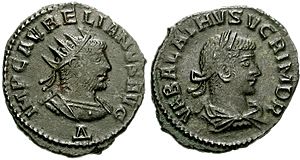
At first, Zenobia tried to avoid upsetting Rome. She and her son used titles that showed they were still subjects of Rome and protectors of its eastern border. After expanding her territory, she seemed to want to be seen as an equal partner in the eastern part of the empire.
In late 270 AD, Zenobia began minting coins with both Aurelian's and Vaballathus's portraits. Aurelian was called "emperor," and Vaballathus "king." This suggested a shared rule. It's unlikely Aurelian truly agreed to this power-sharing, but he was busy with problems in the West. He might have pretended to accept it while preparing for war.
Empress and Open Rebellion
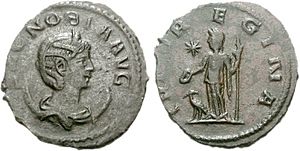
By August 271 AD, an inscription in Palmyra called Zenobia "most illustrious and pious queen," a title used by Roman empresses. By April 272 AD, the mints in Alexandria and Antioch removed Aurelian's portrait from coins. They issued new coins calling Vaballathus "Augustus" (emperor) and Zenobia "Augusta" (empress).
This was a clear declaration of independence and open rebellion against Rome. Zenobia likely understood that a conflict with Aurelian was unavoidable. She claimed the imperial title to rally her soldiers. Aurelian's military campaign seems to have been the main reason for her declaration.
Zenobia's Downfall
The rebellion began in early 272 AD and ended by August of the same year. Aurelian easily took back cities in Asia Minor. Only Tyana resisted for a short time before surrendering. This cleared the way for Aurelian to invade Syria, the heart of Zenobia's empire. At the same time, a Roman army took back Egypt by June 272 AD. Zenobia had likely moved most of her armies from Egypt to defend Syria.
In May 272 AD, Aurelian defeated Zenobia's army, led by Zabdas, at the Battle of Immae near Antioch. Zenobia retreated with her army to Emesa. To hide the defeat, she spread rumors that Aurelian had been captured. Aurelian soon entered Antioch and continued his march south.
He met Zenobia's army of 70,000 soldiers at the Battle of Emesa. The Palmyrene army nearly won, but the Roman infantry managed to attack their sides. Zenobia was defeated and fled to Palmyra, her capital, to prepare for a siege. Aurelian blocked her food supplies. Zenobia tried to escape to Persia to get help, riding a fast camel.
Capture and Fate
Aurelian's soldiers caught Zenobia before she could cross the Euphrates River into Persia. Palmyra surrendered soon after hearing of her capture in August 272 AD. Aurelian sent Zenobia and her son to Emesa for trial, along with many of Palmyra's important people. Some stories say Zenobia blamed her actions on her advisers to save herself, but this might have been Roman propaganda to make her look bad. Aurelian spared Zenobia and her son so he could parade them in his victory celebration in Rome.
Zenobia's exact fate after Emesa is unclear. Some ancient writers say she died before reaching Rome, either from illness or by starving herself. However, most ancient historians and modern scholars agree that Zenobia was displayed in Aurelian's triumph in 274 AD. This public humiliation would have been a way for Aurelian to show he had crushed the rebellion.
Most historians say her life was spared after the triumph. The Augustan History claims Aurelian gave Zenobia a villa near Hadrian's Villa in Tibur, where she lived with her children. Some sources say she married a Roman nobleman or senator. Her house reportedly became a tourist attraction in Rome.
Zenobia's Titles
Zenobia's high position was due to her son being too young to rule alone. An inscription from 263 AD mentions a queen, which some historians believe refers to Zenobia, showing she might have used the title during her husband's lifetime.
An inscription from her early rule calls her "illustrious queen, mother of the king of kings." This was her first official title. A lead token from Antioch also calls her queen.
The first clear proof of Zenobia as queen in Palmyra is an inscription from August 271 AD, calling her "most illustrious and pious queen." She was never recognized as the sole ruler in Palmyra; she was always linked with her husband or son in inscriptions. However, in Egypt, some coins were minted only in Zenobia's name. According to her coins, she took the title of Augusta (empress) in 272 AD, ruling under the name Septimia Zenobia Augusta.
Zenobia's Descendants
Besides Vaballathus, it's not certain if Zenobia had other children. Some scholars believe a child named Hairan (II) seen on a seal with Vaballathus was her son. Another inscription mentions the mother of King Septimius Antiochus, and many scholars think this missing name is Zenobia. Septimius Antiochus was proclaimed emperor in 273 AD when Palmyra rebelled against Rome a second time. If he was Zenobia's son, he was likely very young.
The Historia Augusta mentions two other children, Herennianus and Timolaus, but these names are likely made up. The Historia Augusta also claimed Zenobia's descendants were Roman nobles during the reign of Emperor Valens (364–375 AD). Some historians say Zenobia's descendants lived in Rome for centuries.
Zenobia's Legacy
It's hard to fully judge Zenobia. She was brave when her husband's power was threatened. By taking the throne, she protected the region after his death. She turned what her husband left her into a "shining display of strength." Some historians see her as a strong leader who had a grand vision for her empire.
Zenobia has inspired many people, including scholars, musicians, and actors. Her fame continues in the West and is very strong in the Middle East. As a heroic queen with a sad ending, she is often compared to figures like Cleopatra. Zenobia's story has been reinterpreted over time. She has been seen as a freedom fighter, a hero for the oppressed, and a national symbol.
She is also a role model for women. Catherine the Great reportedly liked to compare herself to Zenobia. In the 1930s, Zenobia became an icon for women in the Arabic-speaking world, seen as a strong, nationalistic female leader.
Her most lasting impact is in Syria, where she is a national symbol. Syrian nationalists see her as a hero. Her image has appeared on banknotes. In 1997, a Syrian TV series about her, Al-Ababeed, was watched by millions in the Arabic-speaking world. This series used her struggle to symbolize the Palestinian struggle for self-determination.
Myths and Popular Culture
Zenobia is often called "one of the most romantic figures in history." It's hard to know the real Zenobia because writers and historians have added their own ideas to her story.
The Augustan History changed its view of Zenobia depending on the emperor it was writing about. At first, it praised her for being a better ruler than a weak Roman emperor. Later, when writing about the victorious Emperor Aurelian, it described Zenobia as guilty, proud, and cowardly.
The Augustan History also emphasized Zenobia's beauty. To make Aurelian's victory seem more impressive, the author gave Zenobia many masculine traits. It said she had a clear, manly voice, dressed like an emperor, rode horses, marched with her army, and enjoyed hunting. This made her seem like a dangerous "Amazon queen" for Aurelian to defeat.
In the 17th century, visitors to Palmyra renewed Western interest in Zenobia. This interest grew in the mid-19th century. Many novels, plays, and operas have been written about her.
Selected Cultural Depictions
- Sculptures:
- Zenobia, Queen of Palmyra (1857) by Harriet Hosmer.
- Zenobia in Chains (1859) by Harriet Hosmer.
- Literature:
- Chaucer tells a short version of Zenobia's story in "The Monk's Tale".
- La gran Cenobia (1625) by Pedro Calderón de la Barca.
- The Queen of the East (1956) by Alexander Baron.
- Paintings:
- Queen Zenobia Addressing her Soldiers by Giambattista Tiepolo (early 18th century).
- Queen Zenobia's Last Look upon Palmyra (1888) by Herbert Gustave Schmalz.
- Operas:
- Zenobia (1694) by Tomaso Albinoni.
- Aureliano in Palmira (1813) by Gioachino Rossini.
- Television:
- Al-Ababeed (1997), a Syrian TV series starring Raghda as Zenobia.
Images for kids
See also
 In Spanish: Zenobia para niños
In Spanish: Zenobia para niños
- Crisis of the Third Century
- Gallic Empire
- Mavia (queen)
- Zenobia of Armenia


